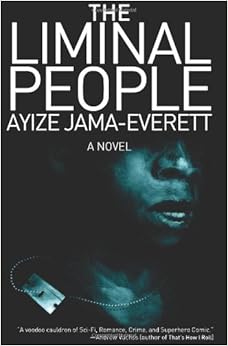The marvelous Bina reviewed The Liminal People some time ago and mentioned that it’s frequently compared to X-Men, which naturally was all the inducement I needed to buy it and its two sequels a few AWPs ago. “X-Men meets [literally anything]” = a sales pitch that will win me over 10/10 times.

Taggert, our hero (ish), is a healer with the power to magically repair any ailments of the body, from wounds to asthma to cancer. He has wandered the world for most of his life, desperate to meet more people with powers like him, and his wanderings have washed him up on the metaphorical shores of a warlord in Morocco, who has helped1 him develop his powers, in exchange for Taggert’s help pursuing the warlord’s own ends. But when Taggert gets a desperate call from Yasmine, the only woman he’s ever loved, he rushes to London to help find her missing daughter — who may have powers of her own.
In so many ways, The Liminal People is the type of fantasy I’m excited to be reading. Jama-Everett takes a familiar trope — the minority population of superheroes — and puts it in global perspective, so that we see how differently Taggert’s powers have been received in the many places he’s lived. Whereas many iterations of this trope have used it as a stand-in for race, The Liminal People looks at how powers like Taggert’s interact with race (and other marginalizations).
It’s also just a good story. I’m never not going to be there for “tough loner teams up with angry youth,” even if we weren’t living through a calendar year that gave us the apparently-very-gruesome-so-I-haven’t-seen-it-yet-please-don’t-@-me Logan. There’s a plot element towards the middle that wasn’t a great look for Feminism, but since it was in clear service of the tough loner / angry youth team-up, I am prepared to overlook it. Jama-Everett is quite fantastic at fight scenes, even if you don’t think you care about fight scenes. His are excellent, weird, and inventive, and they make full use of Taggert’s powers and the powers of the people he’s fighting.
Okay. That’s the good stuff. Now for some things that are not so good in re: the portrayal of villains. One of the big villains of the piece is a hired thug called Rajesh whose powers run to blowing things up. Here’s how Tamara (a protagonist and fundamentally sympathetic character) describes him:
He’s Asian, Paki, I think. . . . He’s a bully. A big stupid Paki bastard bully. He pushes his parents around. I’ve heard he’s raped girls. . . . He’s a savage fucking brute.
I get that troubled youths say gross things and don’t appreciate the impact of their words, but the text doesn’t frame this description as problematic. There is no push-back against the use of the term Paki (which unless I’ve misunderstood England completely is a really racist thing to say), and we don’t see any acknowledgement that Tamara has been ugly here: Her rage and the expression of it appear justified by the text, because Rajesh is a rapist and a murderer.
Moreover, because there are no other significant South Asian characters in the book, the depiction of Rajesh and his family takes on an outsize importance. Unlike the other villains, whom Jama-Everett portrays with more nuance, Rajesh is exclusively, simplistically evil, and the reader is meant to feel viciously satisfied when Taggert tortures and kills him (in the Indian restaurant his parents own). I suspect Jama-Everett didn’t intend to link Rajesh’s nationality with his villainy, but it’s noticeable and really disappointing in a book that gives us a terrific array of superheroes of color.
MOREOVER. The Big Bad of this book is a club promoter called Alia, who uses her powers to conceal her true face. When Taggert and Tamara face off with her in the final battle, they force her to drop her illusions, and she is described in the following super-ableist way:
And she’s ugly. Not everyday ugly — she had major genetic problems: oversized cranium, malformed palette, cleft lip — mother-was-probably-her-sister type ugly. Her teeth are gray and look like they belong to an infant. Her arms are deformed, almost flippers.
It goes on from there but I got depressed typing it and decided to tap out. Like. Number one, can we retire the flippant tone when we’re talking about incest? Number two, the Evil Cripple trope is harmful to disabled people. Number three, the aligning of disability with ugliness is yuck, and both Taggert and Alia explicitly refer to her as ugly (repeatedly). In a book that I generally really loved and found inventive and brilliant, it was disappointing to see it lean on tedious cliches about disability at the end.
If you’ve got other feelings about the portrayal of Rajesh and Alia, and particularly if you want to let me know if there’s stuff I should watch out for in the subsequent two books, I’d love love love you to get at me in the comments.
- for some values of the word “helped” ↩